Cayman Chemical Company,Inc.
入驻年限:4 年
- 联系人:
Kristina Whitfield
- 所在地区:
美国
- 业务范围:
试剂、抗体、细胞库 / 细胞培养、ELISA 试剂盒
- 经营模式:
生产厂商
推荐产品
公司新闻/正文
Small Molecule Inhibitors Selection Guide
人阅读 发布时间:2022-08-17 18:09
Small Molecule Inhibitors Selection Guide
Article from 2019-08-13
Small molecule inhibitors are one of the most accessible and versatile tools available to understand the functions of proteins and their role in normal physiology and disease pathology. To be valuable for interrogating biological processes or validating novel targets, these tools must satisfy necessary criteria that will provide reliable and reproducible data. Because at times it can seem overwhelming to identify the most suitable inhibitor from the plethora of molecules available for use, we gathered a list of parameters that should be considered during the selection process.
As each new small molecule is considered for use in your research, attention must be paid to its 1) chemistry, 2) potency, 3) selectivity, and 4) context of use. It is always best to review scientific literature to understand the well-established tools in your field and the advantages and disadvantages (e.g., cytotoxicity or off-target effects) certain compounds may present. Detailed information about available probes may also be found by using target-centric searches in web-based chemical probe databases such as Chemical Probes Portal, Probe Miner, IUPHAR’s Guide to Pharmacology, and Probes and Drugs. Additionally, Cayman provides pertinent, detailed biological information in each product insert to help you choose the right compound for your experiment. Often for more novel or relatively uncharacterized inhibitors, it may be best to run preliminary tests yourself to understand how the compound will react within your experimental system. While not all compounds need to reach the thresholds suggested below in every case, considering these parameters will help you determine whether the probe will be fit for your purpose.
Chemistry
 |
Structure should be defined, and its synthesis should be reproducible. Avoid common toxic moieties and pan-assay interfering moieties (PAINS). Likewise avoid chemically reactive groups, unless required such as for covalent addition. |
 |
Stability (purity and chemical identity) should be preserved in relevant media with attention made to any pH sensitivity. Activity should remain in culture media. The molecule shouldn’t exhibit non-specific chemical reactivity (e.g., redox reactions or membrane destabilization). |
 |
Solubility should be sufficient in aqueous media (e.g., >10 times the IC50 or >0.05 μg/ml in low % DMSO). Both solubility and lipophilicity need to be balanced. Highly charged, highly soluble compounds may display low cellular or tissue permeability. Hydrophobic compounds may display high permeability and potency, while presenting solubility problems. Use of salt forms of hydrophobic molecules should improve aqueous solubility. |
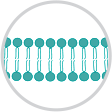 |
Permeability either through passive means or active transport is essential for activity in a cellular assay. Blood-brain barrier penetration is important for desired central nervous system (CNS) effects. Caco-2 cell permeability assays or parallel artificial membrane permeability assays (PAMPAs) are common assays to assess passive diffusion. MDCK-MDR1 permeability can be used for assessment of CNS penetration, including active efflux by P-glycoprotein (PGP). |
Potency
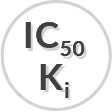 |
IC50 and Ki are the most common ways to denote inhibitor potency. In the context of enzyme inhibition, IC50 indicates the concentration of an inhibitor required to reduce the rate of an enzymatic reaction by 50% under the given experimental conditions. Kidenotes the ratio of inhibitor-target complex breakdown (koff) to inhibitor-target complex formation (kon) for the binding of the inhibitor to the enzyme. The term Ki is a thermodynamic equilibrium constant and is therefore a fixed value. IC50, on the other hand, is a representation of inhibition under a defined set of conditions and will change depending on factors such as the concentration of substrate present in the reaction setting. In the case of competitive inhibitors, IC50 can be related to Ki by the Cheng-Prusoff equation: IC50=Ki*(1+[S]0/Km). This is a useful web-based tool for converting IC50 values to Ki values using different inhibitor binding models. Note that for proteins other than enzymes (such as G protein-coupled receptors or ion channels), antagonist efficacy can also be reported by Ki or IC50. In the case of GPCRs, the IC50 (or often EC50) is an indication of inhibition of a cellular response (i.e., a decrease in cAMP concentration), whereas Ki refers only to binding at the receptor in reference to the natural ligand. |
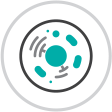 |
In vitro potency benchmark standards are typically IC50 or Ki values <100 nM in biochemical assays and <1-10 μM in cell-based assays. Potency in enzyme assays should correlate with potency in cells. Use the lowest concentration possible to avoid off-target effects. Inhibitors that are effective in cells only at concentrations >10 μM likely target proteins non-specifically. |
 |
In vivo potency benchmark standards should achieve levels in target tissue that are relevant to cellular potency. Attention must be paid to effects related to the absorption, dissolution, metabolism, or excretion of the compound. Metabolic stability is of critical concern, if the compound will advance into animal studies. |
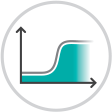 |
Dose-dependent activity should be evident when experiments are performed using a low to high range of recommended concentrations. Near complete inhibition of the target at saturating concentrations confirms the efficacy of the compound. |
 |
Structure-activity relationship (SAR) analysis allows researchers to interpret the binding of a series of compounds with varied activities to an enzyme or receptor so as to understand the requirements, allowances, and constraints of target protein binding. It is important that an SAR series cover >3-4 orders of potency magnitude. A “flat” SAR, where an entire series of compounds covering large structural differences all possess near-equivalent and weak potency, can suggest increased difficulty drugging a target. |
Selectivity
 |
Profiling will define the selectivity for related targets, which is often a more critical factor than potency. Typically, in biochemical assays, a factor of >10-100-fold in potency for the target against other family members defines an inhibitor as selective for that target. Inhibitors designed to be selective for your target of interest may still bind other proteins at higher concentrations. It is important to be aware of any additional activities associated with a particular chemical class. |
 |
Negative control experiments can be designed to demonstrate that the inhibitor does not effectively alter the function of any off-target proteins at the concentration used to inhibit the desired target. Well-considered negative controls such as exposing cells or proteins only to the solvent or substituting closely related inactive structural analogs, such as R/S stereoisomers, help confirm the effect of the inhibitor. |
 |
Positive control experiments can be used to demonstrate the inhibitor is behaving as intended in instances where an effect is not evident. This control group is not exposed to the experimental treatment but instead exposed to some other treatment that is known to produce the expected effect. |
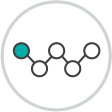 |
Orthogonal probes with similar activity but from a different chemotype and/or mode of action may also be considered for use as additional controls. If the orthogonal probe generates a similar response, then it is more likely that inhibition of the target is responsible for the observed phenotype. If it doesn’t, then confounding off-target or toxic effects may be caused by the inhibitor. |
Context
 |
Mechanism of action is important to further define the nature of the inhibitor in order to determine how natural substrates at physiologic concentrations will modulate inhibitor efficacy and to identify any vulnerabilities associated with this mechanism. Potential inhibition events include: |
 |
|
|
|
 |
|
 |
|
 |
|
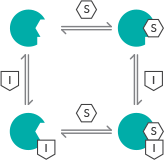 |
|
 |
|
 |
|
 |
|
 |
|
 |
Inhibitor-target kinetics that dictate target engagement including the kon, residence time, and koff add an additional dimension to the potency and selectivity of the compound. Compounds that dissociate slowly from their targets may have prolonged activity at lower concentrations, enabling dosing levels or dosing frequency to be reduced. Often residence time can correlate better with in vivoactivity than thermodynamic potency. |
 |
Target vulnerability is a function of the minimum level of target engagement required for an effect to be observed. High-vulnerability targets require low levels of target occupancy (that is, lower levels of inhibitor exposure) to achieve the desired effect. Cell-based washout experiments can provide insight on target vulnerability by helping to determine the phenotypic consequences of target engagement once the inhibitor is removed from the system. |
 |
Physiological context of the target and the downstream consequences of target engagement must be considered. For instance, disrupting an enzyme that catalyzes the rate-limiting step of a metabolic pathway might have greater consequences compared to other enzymes in the pathway. Within the antibacterial or anticancer context, inhibition of final steps within a biochemical pathway, downstream of high-energy/high-cost biochemical products, can prove to be especially toxic to the targeted cell. |
 |
Timeframe required for an expected phenotypic effect or to trigger a cascade of signaling events should be considered in the design your assay to capture this length of time accordingly. |
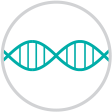 |
Complimentary experiments using available RNAi or mutants, when available, help to build consensus about the role of a given target in a biological system. |
 |
Application fitness of the compound to the target will ultimately be governed by how well it links to the biological context of the hypothesis under investigation, since the use of an inhibitor in one biological system may not necessarily extrapolate to another. An inhibitor that is fit-for-purpose will be appropriate to both the target and the broader scientific context. |
 |
Availability of the compound is widespread and is obtainable in quantities that allow for follow-up uses. |










